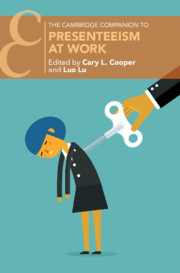Book contents
- Presenteeism at Work
- Cambridge Companions to Management
- Presenteeism at Work
- Copyright page
- Contents
- Contributors
- Foreword
- Introduction
- Part I Situating Presenteeism on the Global Stage
- 1 Presenteeism: An Introduction to a Prevailing Global Phenomenon
- 2 Presenteeism: A Critical Review of the Literature
- 3 Understanding the Excessive Availability for Work in the Confucian Asia: Interactions between Sociocultural Forces and Personal Drives
- Part II Understanding the Behavior of Presenteeism
- Part III Understanding the Consequences of Presenteeism
- Part IV Understanding Presenteeism in a Cross-Cultural Context
- Index
- References
3 - Understanding the Excessive Availability for Work in the Confucian Asia: Interactions between Sociocultural Forces and Personal Drives
from Part I - Situating Presenteeism on the Global Stage
Published online by Cambridge University Press: 09 August 2018
- Presenteeism at Work
- Cambridge Companions to Management
- Presenteeism at Work
- Copyright page
- Contents
- Contributors
- Foreword
- Introduction
- Part I Situating Presenteeism on the Global Stage
- 1 Presenteeism: An Introduction to a Prevailing Global Phenomenon
- 2 Presenteeism: A Critical Review of the Literature
- 3 Understanding the Excessive Availability for Work in the Confucian Asia: Interactions between Sociocultural Forces and Personal Drives
- Part II Understanding the Behavior of Presenteeism
- Part III Understanding the Consequences of Presenteeism
- Part IV Understanding Presenteeism in a Cross-Cultural Context
- Index
- References
Summary

- Type
- Chapter
- Information
- Presenteeism at Work , pp. 69 - 94Publisher: Cambridge University PressPrint publication year: 2018
References
- 2
- Cited by

